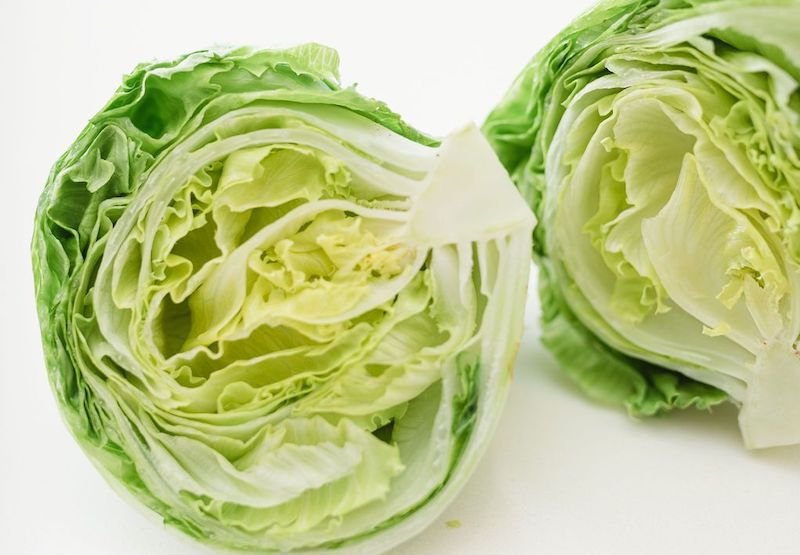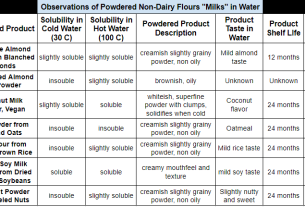Have you ever found yourself with a wilted, sad-looking lettuce at the back of your fridge, wondering how long it had been there?
We’ve all been there.
But fear not, because in this article, we’re about to uncover the secrets of lettuce longevity.
Whether you prefer crisp iceberg, vibrant romaine, or delicate loose leaf, we’ll explore the storage methods, optimal humidity levels, and telltale signs of spoilage.
Get ready to unlock the key to preserving your leafy greens and say goodbye to mushy salads forever!
how long does lettuce last
Head lettuce like iceberg or romaine can last for 1 to 3 weeks, while loose-leaf lettuce like butterhead or green leaf typically lasts for 7 to 10 days.
When stored properly, lettuce leaves can last up to 7 days.
Crisphead lettuce tends to last longer than leaf lettuce because the outer leaves protect the inner ones.
Proper storage involves wrapping lettuce well and allowing airflow to get rid of excess moisture.
Lettuce can be stored at room temperature for 2 to 4 days, but it will last longer in the fridge.
In the fridge, lettuce can last between 7 and 21 days, depending on the type.
It is important to manage humidity to keep lettuce fresh, and allowing airflow through a half-open or ventilated plastic bag can help control humidity.
Avoid storing lettuce near ethylene-producing fruits and vegetables, as it can cause red and brown spots.
Signs of spoiled lettuce include mushy, slimy, soft, darkened leaves, and a bad smell.
If more than 2 to 3 layers of leaves are affected, the entire lettuce should be discarded.
Key Points:
- Head lettuce can last 1 to 3 weeks, while loose-leaf lettuce typically lasts 7 to 10 days.
- Properly stored lettuce leaves can last up to 7 days.
- Crisphead lettuce lasts longer than leaf lettuce due to outer leaf protection.
- Proper storage involves wrapping lettuce well and allowing airflow to remove excess moisture.
- Lettuce can be stored at room temperature for 2 to 4 days, but lasts longer in the fridge.
- Lettuce can last between 7 and 21 days in the fridge, depending on the type.
how long does lettuce last – Watch Video
💡
Pro Tips:
1. Lettuce was first cultivated by the ancient Egyptians around 2680 BC. It was highly valued and considered a symbol of fertility and love.
2. The average lifespan of lettuce can vary depending on the variety. While iceberg lettuce usually lasts for about one to two weeks, leafy greens like spinach or arugula may only stay fresh for around three to five days.
3. If you want to extend the lifespan of your lettuce, try wrapping it in a damp paper towel and storing it in a sealed plastic bag in the refrigerator. This helps maintain the moisture and freshness, keeping it crispy for a longer period.
4. Lettuce contains a significant amount of water, making up about 96% of its total weight. This high water content contributes to its refreshing and hydrating properties.
5. Contrary to popular belief, lettuce is not just a source of water and fiber; it also contains some essential nutrients. It is particularly rich in vitamin K, which plays a vital role in blood clotting and bone health.
1. Head Lettuce Lasts 1 To 3 Weeks
Head lettuce, such as iceberg or romaine, is a staple in many households. The good news is that head lettuce can last for a considerable amount of time if stored properly. On average, head lettuce can stay fresh for 1 to 3 weeks. This is because the outer leaves of head lettuce provide protection for the inner ones, helping to keep them crisp and free from damage. However, it is important to note that the exact lifespan of head lettuce can vary based on factors such as freshness at the time of purchase and how it is stored.
- Head lettuce, such as iceberg or romaine
- Can stay fresh for 1 to 3 weeks
- Outer leaves protect the inner ones, keeping them crisp and undamaged
“The lifespan of head lettuce can vary based on factors such as freshness at the time of purchase and how it is stored.”
2. Loose Leaf Lettuce Lasts 7 To 10 Days
Unlike head lettuce, loose leaf lettuce, including varieties like butterhead or green leaf, has a shorter storage time. Loose leaf lettuce can last for about 7 to 10 days when stored properly. The reason for the shorter lifespan is that the inner leaves of loose leaf lettuce have direct exposure to the environment, leading to faster degradation after harvest. Therefore, it is crucial to consume loose leaf lettuce within the recommended timeframe to ensure optimal freshness and taste.
3. Lettuce Leaves Can Last Up To 7 Days With Proper Storage
If you prefer to purchase individual lettuce leaves, you’ll be glad to know that they can last up to 7 days when stored properly. However, it is important to point out that the storage time for lettuce leaves can be influenced by factors such as the variety of lettuce, freshness, and storage conditions.
To maximize the lifespan of lettuce leaves, it is vital to maintain proper storage techniques and monitor for any signs of spoilage.
- Store lettuce leaves in a plastic bag or airtight container to prevent wilting and moisture loss.
- Refrigerate the lettuce leaves at a temperature between 32-36°F (0-2°C), which helps to maintain their freshness.
- Avoid storing lettuce near fruits that produce ethylene gas, such as apples and bananas, as this can accelerate spoilage.
- Inspect the lettuce leaves before use and discard any that show signs of wilting, browning, or sliminess.
- If you want to extend the storage time, consider washing and drying the lettuce leaves before storage to remove excess moisture.
To sum up, by following these tips and taking the necessary precautions, you can enjoy fresh and crisp lettuce leaves for up to 7 days.
“Proper storage and careful monitoring are essential in preserving the quality and longevity of lettuce leaves.”
4. Crisphead Lettuce Lasts Longer Due To Outer Leaf Protection
Crisphead lettuce, such as iceberg lettuce, is popular for its dense head and crunchy texture. One advantage of crisphead lettuce is its extended lifespan compared to leaf lettuce. The outer leaves of crisphead lettuce serve as a protective layer, safeguarding the inner leaves from harm and increasing overall longevity. By preserving the integrity of the outer leaves, crisphead lettuce remains fresh for a longer period, ensuring you can savor its crispness and flavor.
5. Proper Storage Includes Wrapping And Airflow
Proper storage techniques are crucial for maintaining the freshness and shelf life of lettuce. To effectively store lettuce, it is important to follow these steps:
-
Wrap lettuce well: Use a plastic bag with a half-open or ventilated design to allow airflow. This helps in maintaining the balance of moisture and prevents wilting or sliminess.
-
Eliminate excess moisture: Proper airflow is essential to eliminate excess moisture. This can be achieved by wrapping the lettuce in a well-ventilated plastic bag.
-
Avoid overcrowding: It is important not to overcrowd the storage container. Overcrowding can lead to increased moisture accumulation, which in turn accelerates decay.
In conclusion, proper storage of lettuce involves wrapping it well to allow airflow, eliminating excess moisture, and avoiding overcrowding. Following these techniques will help prolong the freshness and extend the shelf life of lettuce.
- Wrap lettuce well in a plastic bag with a half-open or ventilated design
- Eliminate excess moisture by allowing airflow
- Avoid overcrowding in the storage container
“Proper storage of lettuce is key to prolonging its freshness and extending its shelf life.”
6. Shorter Storage Time For Loose-Leaf Lettuce
As mentioned earlier, loose-leaf lettuce has a shorter storage time compared to head lettuce. The reason behind this is that loose-leaf lettuce lacks the protective outer leaves found in head lettuce, exposing the inner leaves to the environment. Consequently, loose-leaf lettuce tends to degrade and wilt more rapidly after harvest.
To ensure the longest possible lifespan for loose-leaf lettuce, it is advisable to:
- Consume it within the recommended storage timeframe.
- Store it in ideal conditions.
“To ensure the longest possible lifespan for loose-leaf lettuce, it is advisable to consume it within the recommended storage timeframe and store it in ideal conditions.”
7. Lettuce Lasts Longer In The Fridge
When it comes to storing lettuce, refrigeration is the preferred method due to the longer storage time it provides. While lettuce can be stored at room temperature for 2 to 4 days, it will last significantly longer in the fridge. Depending on the variety of lettuce and storage conditions, lettuce can last between 7 and 21 days when refrigerated. Therefore, if you want to extend the lifespan of your lettuce, it is highly recommended to keep it in the fridge.
8. Refrigeration Extends Lettuce Lifespan
Refrigerating lettuce is a reliable way to prolong its freshness and prevent spoilage. However, it is important to manage humidity levels to ensure optimal storage conditions. Lettuce requires a balance of moisture to remain crisp and avoid wilting or developing a slimy texture.
To achieve this, it is advisable to store lettuce in a half-open or ventilated plastic bag in the crisper drawer of the refrigerator. This allows for proper airflow and humidity control, reducing the risk of excess moisture buildup.
- Use a half-open or ventilated plastic bag
- Store lettuce in the crisper drawer
- Maintain proper airflow and humidity control
9. Managing Humidity Is Essential For Fresh Lettuce
Humidity management is essential for keeping lettuce fresh in the refrigerator. High humidity can cause lettuce to wilt and become slimy, while low humidity can lead to dryness and loss of crispness.
To maintain the optimal freshness, it is recommended to store lettuce in the fridge with airflow. This can be achieved by keeping a half-open or ventilated plastic bag. Such a setup allows excess moisture to escape, while maintaining the desired humidity level.
In summary, to keep your lettuce fresh and crisp, follow these tips:
- Store lettuce with airflow using a ventilated plastic bag
- Avoid high humidity to prevent wilting and slimy texture
- Prevent low humidity to retain crispness
- Allow excess moisture to escape while maintaining the desired humidity level
“Strike the right balance with humidity management to enjoy fresh and crispy lettuce.”
10. Avoid Ethylene-Producing Fruits And Veggies For Lettuce Storage
Ethylene is a naturally occurring gas that speeds up the ripening and decay process in fruits and vegetables. It is important to keep lettuce away from ethylene-producing fruits and veggies, such as apples, bananas, and tomatoes, to retain its fresh appearance and taste for a longer period. These ethylene producers can cause red and brown spots to develop on lettuce, leading to a deterioration in quality.
Lettuce can last for varying lengths of time depending on the type and storage conditions. Head lettuce like iceberg or romaine can last for 1 to 3 weeks, while loose leaf lettuce lasts for 7 to 10 days. Lettuce leaves, when stored properly, can last up to 7 days.
Proper storage techniques involve wrapping lettuce well and allowing airflow to eliminate excess moisture. Refrigeration is recommended to extend lettuce’s lifespan, and managing humidity is essential to keep it fresh. It is important to store lettuce away from ethylene-producing fruits and vegetables and monitor for signs of spoilage. By following these guidelines, you can maximize the lifespan of your lettuce and enjoy its crispness in your salads and sandwiches.
💡
You may need to know these questions about how long does lettuce last
How long can I keep lettuce in the fridge?
To keep lettuce fresh in the fridge, it is recommended to wrap it in a dish or paper towel to absorb any moisture. By placing it in the crisper drawer, the lettuce can be stored for one to three weeks. Loose leaf lettuce, with the help of a towel to absorb excess moisture, can be expected to stay fresh for approximately a week or 10 days.
Can you eat lettuce after 2 weeks?
While it is generally not recommended to consume lettuce after the “enjoy by” date, our lettuce, if stored correctly and still in good condition, can be safely consumed even after two weeks. As long as the lettuce maintains its freshness, crispness, and lacks any signs of spoilage such as slime, it should still be enjoyable and safe to eat. So, if you have lettuce in your fridge that looks and smells good even after two weeks, go ahead and enjoy it without concern.
How do you know when lettuce goes bad?
You can easily tell if lettuce has gone bad by checking for visual signs and evaluating its texture and smell. Fresh lettuce should have a crisp and firm texture, breaking or cutting it to see if it snaps is a good indicator of its freshness. Even if there are some red areas, the lettuce can still be considered fresh. On the other hand, if you notice any black spots, sliminess, or an unpleasant odor, it’s a clear sign that the lettuce has passed its prime and it’s best to discard it.
How long until lettuce goes bad?
The longevity of lettuce largely depends on how it is stored. When stored correctly, leafy greens can remain fresh and crispy for a duration of 7 to 10 days. However, it should be noted that a whole head of lettuce tends to last longer than individual greens. Tightly bound heads like iceberg and endive have an extended shelf life compared to loose leaf varieties. Taking the appropriate storage measures ensures that your lettuce stays fresh and enjoyable for a considerable period.
Reference source
https://www.tasteofhome.com/article/tips-tricks-keep-lettuce-fresh/
https://www.southernliving.com/how-to-store-lettuce-so-it-stays-crisp-7090549
https://littleleaffarms.zendesk.com/hc/en-us/articles/360057060573-Can-I-eat-lettuce-after-the-enjoy-by-date-
https://brightly.eco/blog/is-red-lettuce-safe-to-eat



